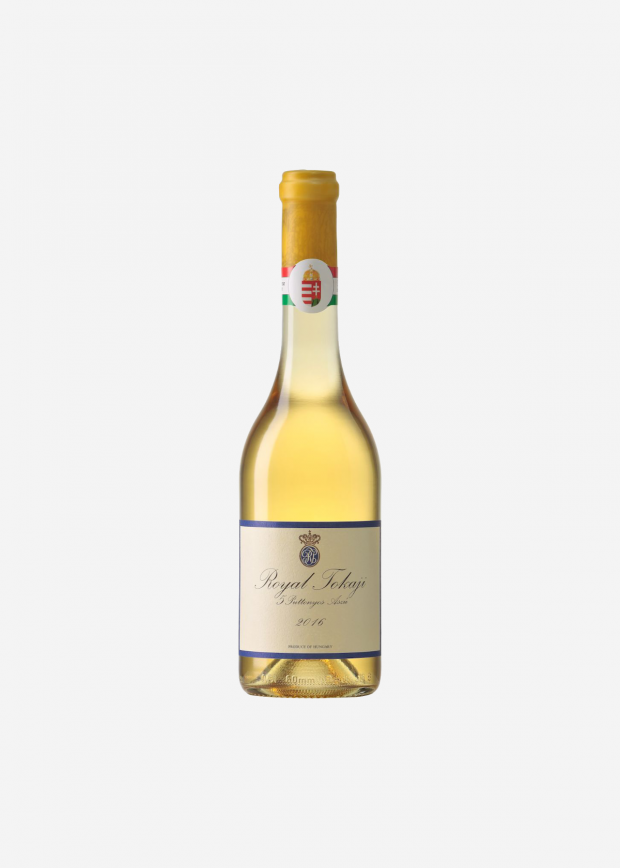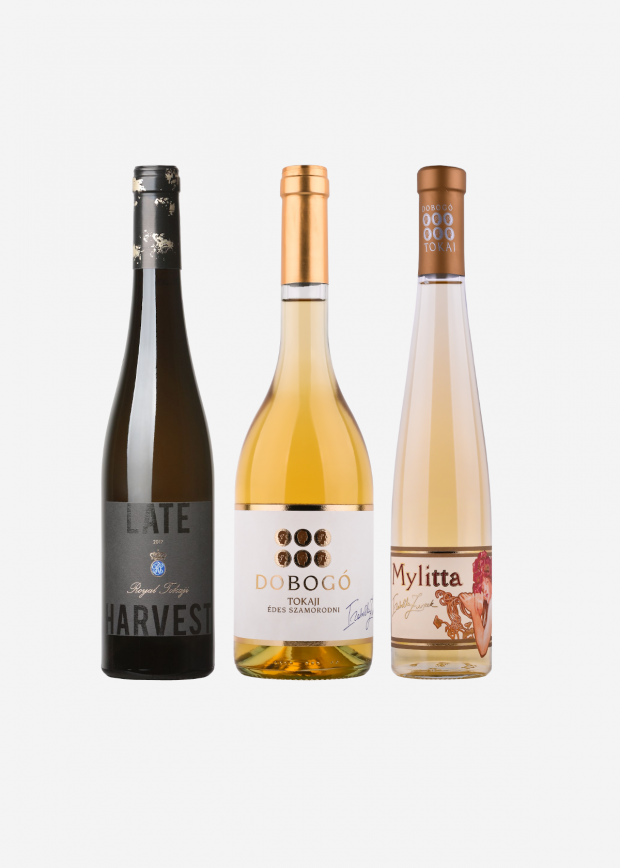Aszú and Szamorodni, the Tokaj sweet wines, are frequently referred to as the golden liquid of Tokaj, and if you look at a bottle of Aszú or Szamorodni it is not difficult to figure out why: they have a deep yellow color. However, there are a couple of other wine styles worth drinking.
These are the best Hungarian wines for sure and worth tasting them, many of them in the top range of Decanter World Wine Award and Berliner Wine Thropy in every year.
Pairing sweet Tokaj wines with meals
Tokaji sweet wines have a high acidity and sugar content, and botrytis adds another vital character to the flavor profile, determining the food they are matched with. Tokaj late-harvest wines are generally well-matched with duck liver, goose liver, poppy seed dumplings, liver loops, and cottage cheese cakes.
Szamorodni and Aszú, made from botrytized grapes, are, in our opinion, the best pairing in the world with milk chocolate. The high acidity of the Szamorodni and Aszú wines holds the high fat content of milk chocolate very well, while the high sugar content of these wines is not overwhelmed by the sweetness of milk chocolate.
In international cuisine, the best pairing of strongly spiced oriental cuisine is Thai food. These wines go very well with Pad Thai noodles, Tom Yum soup, and Thai curries.
Aszú – The Tokaj sweet wine No.1.
Super concentrated, complex, golden-colored wine with high sugar content, refreshing high acidity and a lot of aromas. Aszú production begins making starts with the harvest, which only happens when the grapes have achieved botrytis (also known as “noble rot”). They turn into shriveled raisin-like berries with concentrated levels of sugar and aromas, and then they are selectively harvested—one at a time, by hand—multiple times. A law was passed in 2013 which requires that one kilogram of Aszú berries make no more than 2.2 liters of Aszú wine.
How to produce Aszú?
Aszú berries long ago stopped being harvested into the puttony (and since 2013 puttonyos are no longer used as an official measure of sweetness). Nowadays, Aszú is measured by its residual sugar (which has to be a minimum of 120 grams per liter), so only wines, which would have formerly been 5 and 6 puttonyos, are allowed in this category. The berries are then mashed into a paste that they call “Aszú dough,” and a fermenting must or a base wine is added so it can macerate for up to 2 days. The mixture is then put into special 136-liter Gönci barrels (made of Hungarian oak from the nearby Zemplén forest) to finish fermenting and to age for a minimum of two years (at least 18 months of which should be in oak barrels). Aszú is most often made as a blend (with Furmint or Hárslevelű usually being the primary component combined with Yellow Muscat and 3 other local grape varieties), but there are also some single varietal versions.
How does Tokaji Aszú taste?
The Tokaji Aszú has a very rich, multi layered texture with amazing complexity and the flavors of plenty of dry fruits (raisin, apricot, candied orange peel), yellow blossom, honey, marmalade, some herbal or medicinal notes, nuts and a hint of lingering minerality at the end. On older bottles you may come across Tokaji Aszúeszencia, made by adding even more shriveled berries to the base wine, however the category is no longer permitted. Maximum yield is 10 t/ha obtained from grapes.

Szamorodni – The Tokaj sweet wine No.2.
This is an important and traditional Tokaji category, and these wines can be made in either a sweet or a dry style. Originally called Főbor (main wine), the name Szamorodni was later adopted. Derived from a Polish word, meaning, “as it was born”. Whole clusters of grapes, which contain a mixture of both botrytized and healthy grapes, are harvested late (without the individual berry selection as in Aszú). The resulting wine can be either dry or sweet depending on the sugar content of the grapes. The sweet Szamorodni (with higher percentage of botrytis and higher sugar level) can be very close in style to the Aszú.
Sweet Szamorodni
Must be aged in oak barrels for at least 12 months, and another 12 months in the bottle. Maximum yield is 10 t/ha.
Dry Szamorodni
A rare, oxidized, sherry-like wine style, the sugar content is fermented fully or almost fully, so it lacks the sweetness of sweet Szamorodni, but it has an exceptional taste. Goes well with matured cheese.
Late harvest – New way of Tokaj sweet wines
Kései szüret wines first began appearing in the mid-1990s. Made from late-harvested, over-ripened grapes (which are not necessarily botrytized), these wines have a bit less complexity than Szamorodni, but are still very delicate wines. Generally lively and fresh, this category doesn’t have any ageing requirements, and they are generally aged for just a few months. Maximum yield is 10 t/ha obtained from grapes.
Fordítás – Byproduct of Tokaj sweet wines No.1.
Once it was popular in Tokaj but is now quite a rare category. Fordítás means “turning over” as the wine is made from the second pressing after Aszú is made. The pressed Aszú dough still contains plenty of sweetness and aroma components, which is soaked again in a fresh or base wine, resulting in Fordítás. In terms of the recipe, winemakers typically use a one-to-one ratio for the quantity of base wine which they use to soak one kilogram to the aszú paste. Generally aged for at least a year in barrel and then a year in bottle. Fordítás is not as elegant or full bodied as Aszú or Szamorodni, but it does have all of the wonderful botrytis character and flavors, as well as plenty of tannins. The sugar level must be at least 120 grams per liter (which is the same as a 5 puttonyos wine). Must be aged in oak barrels for at least 12 months, and another 12 months in the bottle. The maximum yield is 10 t/ha obtained from grapes.
Máslás – Byproduct of Tokaj sweet wines No.2.
Similar to Fordítás, Máslás is another by-product of Aszú. However, it is no longer permitted in Tokaj. The name of the wine means “copy” and was made by pouring must on the Aszú lees (the sediment that has accumulated during fermentation and aging) and then fermenting it again. Fordítás and Máslás have been described as “Aszú’s of the second try”. The wine must be aged in oak barrels for at least 12 months, and another 12 months in the bottle. Maximum yield is 10 t/ha obtained from grapes.
Eszencia
is not strictly a wine because its high sugar content causes it to ferment extremely slowly, never reaching more than four to six percent alcohol even after fermenting for years. Eszencia is only made in particular vintages and can reach 600 to 800 g/liter of residual sugar. To make eszencia, a vat is filled with Aszú berries and the pressure of the grapes pushing produces the free-run juice that is Eszencia. It’s like a thick, honey-like syrup, which is fermented in glass demijohns. Eszencia is often served on elegant, specially made glass spoons. For most people, it’s a once-in-a-lifetime wine to taste if they are visiting the Tokaj region. Elsewhere, it’s very hard to find (and very expensive!). Maximum yield is 2 t/ha obtained from grapes.
Aging potential
Depends on the style of the sweet Tokaj wines, but each category has long ageing potential. Late harvest has between 5-10 years, the Szamorodni has 10-15 years and the Aszú wines have 15-50 years.
Market position and potential
Domestically Tokaj wines are the most well-known sweet wines of Hungary. Internationally, Tokaj is also world famous (one of the world most well-known sweet wines) and this is why it has a great potential abroad as well, even though the world consumption of dessert wines is less and less every year.
Tokaji Aszú and Szamorodni wines on Vinotek.hu
-
 Furmints of Tokaj- 3 bottles€28,37
Furmints of Tokaj- 3 bottles€28,37
(On the featured photo: bunch of botrytised Furmint grape – Source:Shutterstock.com)









1 Comment for “Aszú and Szamorodni – Tokaj sweet wines”